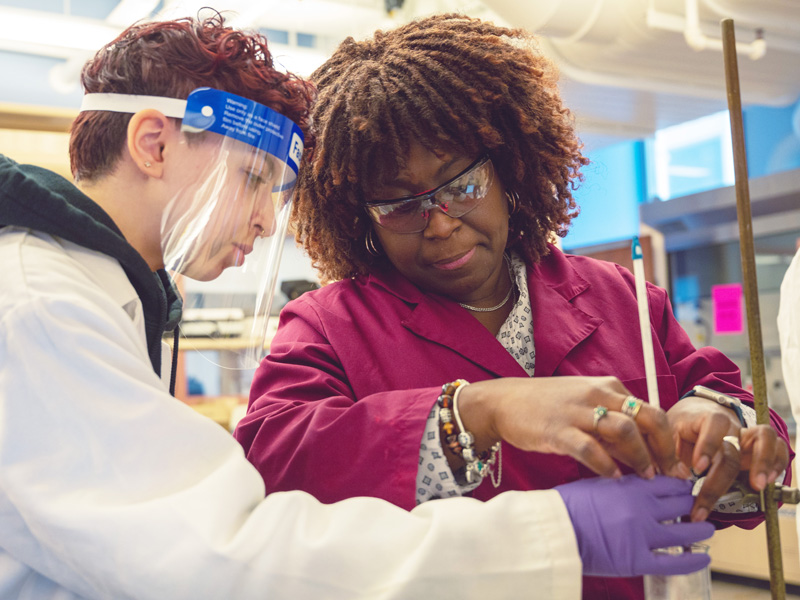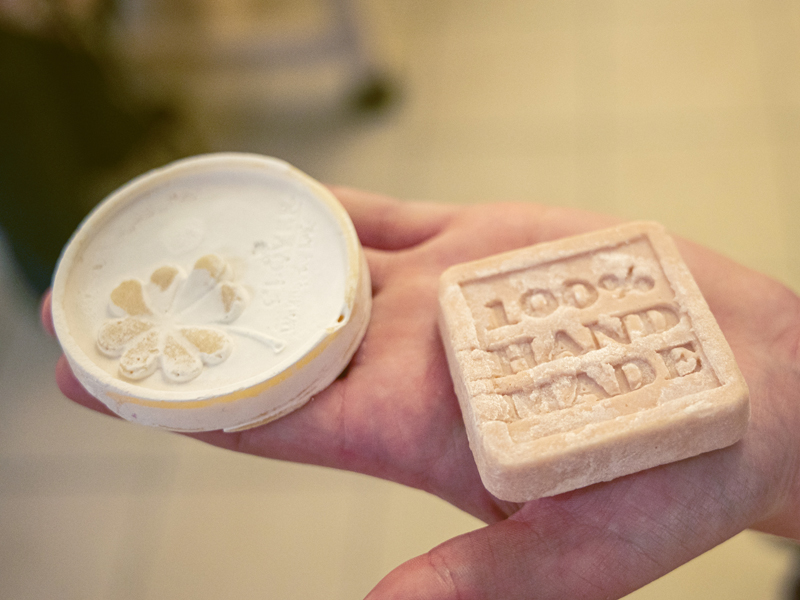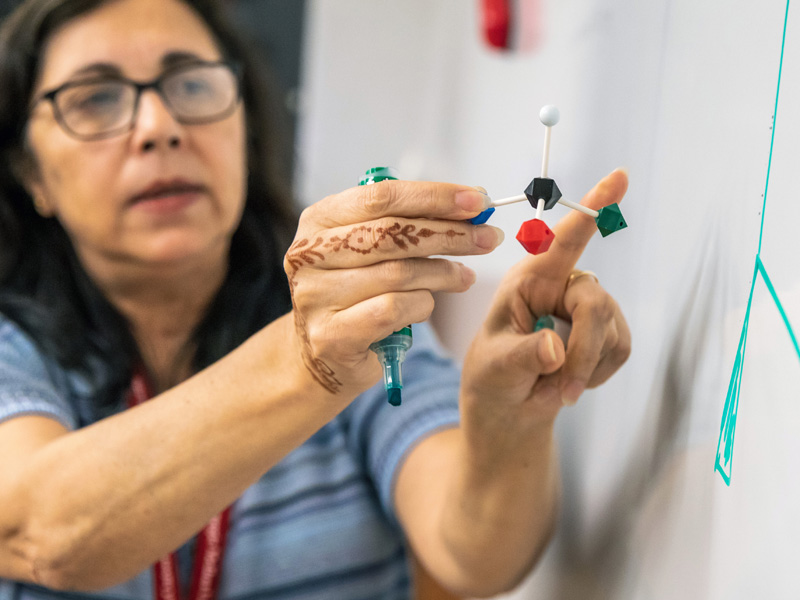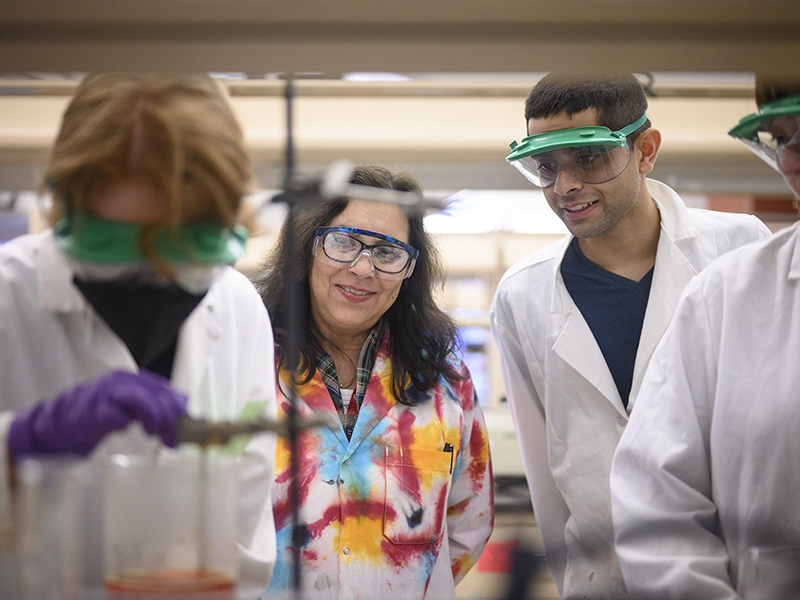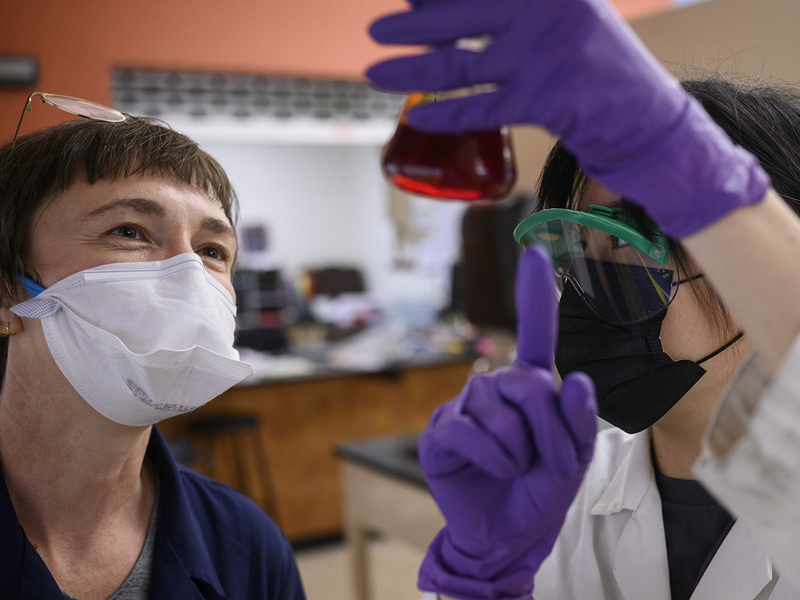Faculty Notes
Courses explore chemistry of cosmetics, clothes and cuisine
“We try for students to become aware of what happens outside of their majors,” said Gloria Silva, an associate teaching professor of chemistry. “If they are chemistry majors, then we link what they’re learning in the classroom to what they see everyday.”
Gizelle Sherwood, an associate teaching professor of chemistry, said that there is a perception that chemistry — and science in general — can be intimidating. While it is a foundational part of science, not everyone grasps that chemistry is all around.
“We’re doing chemistry when we boil ramen and decide how high we put the heat up on the water. Baking is no different than what we do in an organic lab: we measure and put recipes together. That’s chemistry,” Sherwood said.
The Design and Making of Skin and Hair Products
The course is taken from students across the university. In its current iteration, students learn about the chemical components in cosmetic products and the methods for preparing items such as shampoos, conditioners, lotions, soaps and creams. The course includes a hands-on laboratory experience. With regular guest lecturers from the School of Design, students also delve into marketing products.
Among the class’s alumni is Ananya Kapur, who graduated in 2021 with a degree in chemistry and an additional major in business administration. Kapur founded the cosmetics company Type Beauty right after graduation, but she made her first lipstick in Sherwood’s course.
“It was my first time. I had already decided that was the direction I was going to go in. I love being in the lab. It’s so fun to see something that you start from scratch and materialize into an actual product,” said Kapur, whose New Delhi-based company has garnered mentions in Vogue, Elle and Harper’s Bazaar.
Sherwood, who is from Trinidad and Tobago, came to CMU for her Ph.D. in chemistry. When she first arrived in Pittsburgh, she said shopping for haircare products could be a challenge because they were separated from other items.
“For me, a Black female, that was kind of crazy,” she said. “Ethnic shampoo has the same ingredients as any other shampoo, but maybe different concentrations of oils. Yet, my shampoo needs its own section.”
With the beauty industry intersecting with people in different ages, races, gender identities, cultures and religions, Sherwood applied for and won a Provost Inclusive Teaching award, which provides a $5,000 fellowship for faculty working with Carnegie Mellon’s Eberly Center for Teaching Excellence and Educational Innovation to develop and disseminate new approaches to inclusive and equitable teaching in their classrooms.
“I wanted to get at the individual and to have diversity and inclusion. That meant everyone not only understood individually what the chemistry was for themselves but what it means for other people and their worldviews,” she said.
Sherwood and Eberly Center collaborators also found that by the end of each course, students were making more conscious decisions related to the sustainability and environmental impact of products they were purchasing.
“We are seeing this sense of people feeling more empowered by the choices they make,” said Sherwood, who won the Mellon College of Science’s 2020 Julius Ashkin Teaching Award for her devotion and effectiveness in teaching.
The Illusion and Magic of Food
On a recent trip to Carnegie Mellon University in Qatar, Silva set students to testing the pH balance of coffee, apples and other foods. The session was her second iteration of the course Basics of Food Science, which this semester was taught as part of the micro course program for CMU-Q. This course was designed after The Illusion and Magic of Food, a minicourse taught every fall since 2016 at the main Pittsburgh campus.
“One of the things we tested was if black coffee has the same pH level as coffee and milk,” Silva said. Turns out milk’s pH is slightly more neutral than coffee so when it is added to coffee the drink is a little less acidic.
The course sheds light on the main nutrients found in food and their properties as well as discusses processing techniques and ingredients added to extend the shelf life or enhance its appearance.
“My intention is that they learn a little bit about what’s going on in their food to make informed decisions about what they choose to eat,” Silva said. “Some people will learn how to improve their cooking through chemical reactions that are happening. They also learn what benefits that food can bring through choosing proper type of foods for their health.”
While certain foods can have prestige attached to them, such as chocolate, Silva also addresses problems like child labor and conditions related to the food industry. For example, she has students watch the documentary “Food Inc.” to understand the social and environmental costs behind inexpensive food.
Silva’s food courses have been popular, and she has taught variations for interdisciplinary first-year seminars and the Osher Lifelong Learning Institute.
“In the Osher course, I was meeting these people with all of their life experience where we exchanged ideas and opinions,” Silva said.
Fatima Yousaf, a sophomore in computer science, and Jemal Velihanova, a first-year student in biological sciences, select chocolates during Gloria Silva’s microcourse for students at Carnegie Mellon University in Qatar’s Doha campus.
The Culture of Color
Silva and Olivia Robinson, a teaching professor for the Entertainment Technology Center, co-taught The Culture of Color: Dyes, Chemistry and Sustainability. Housed within the Department of Chemistry, the course was offered through Carnegie Mellon’s Integrative Design, Arts and Technology (IDeATe) network.
For Silva, a core component of what she wanted students to take away from the experience was to understand how chemistry influences their lives as well as understand techniques to isolate natural pigment for dyes and how to produce dyes synthetically. Recognizing sustainability issues related to the dyeing and textile industry is also a central topic of the course to educate responsible citizens.
“Everyone has a relationship with some sort of textiles,” added Robinson, who manages IDeATe’s Soft Technologies studio, teaches other textile courses and is a multimedia artist. “Understanding the historical, societal and sustainability contexts related to textile dyeing can further deepen one’s engagement and creativity,” she said.
“Dyeing textiles has a long history of rich cultural traditions and technical innovations,” Robinson said. “While trying to synthesize quinine in 1856, a British chemist named William Perkins created the first synthetic dye. It opened a world of possibilities for both chemists and cloth dyers.”
Erin Smith, a junior in chemistry grew up sewing with her mother and thought the course would be a fun elective. She said that creating dye from natural materials was an interesting process.
“Dyeing with sage created these pretty yellow-green colors. It’s been fun to see a more creative side to chemistry,” Smith said. Having her studies interrupted by the COVID-19 pandemic, she said that time in the lab with courses like this has been valuable. “It’s cool to have physical items that you can touch and do hands-on work.”
Students applied dyes to textiles via methods such as immersion dyeing, resist and folding techniques and printing.
Depending on the day’s assignment some classes took place in the IDeATe collaborative making facility in the basement of Hunt Library or at the state-of-the-art chemistry facility at Doherty Hall.
The IDeATe network connects diverse strengths across Carnegie Mellon to advance education, research and creative practice in domains that merge technologies and arts expertise. Courses are hands-on collaborative learning and structured to combine students from different disciplines. Silva said that using both spaces exposes students in different disciplines to new ideas.
“If someone from chemistry has never been to the IDeATe space, it’s there for them to create things, that’s fantastic,” she said.
■ Heidi Opdyke

